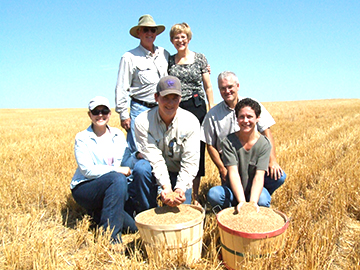What Does a Bushel of Wheat Mean to Me
Bushels, bushels, bushels. Wheat yields are calculated as bushels per acre, wheat prices are cited as dollars per bushel and overall bushels produced determines whether or not Kansas keeps its top wheat production spot. But, what exactly is a bushel? And what does a bushel mean for a consumer?

The Brown family (Colby, Kansas) cut the 25 billionth bushel of wheat grown in Kansas.
In reality, Kansas wheat is used not only for producing flour and making wheat foods. Approximately half of wheat produced in Kansas is exported to other countries. Other bushels are used for anything from livestock and aquaculture feed to plastics. This statistical extrapolation, however, attempts to translate the importance of Kansas wheat to our dinner plates based on total volume.
A Bushel, A Basket
At its simplest, a bushel is a unit of measurement. According to the Encyclopedia Britannica, the U.S. bushel was derived from the Winchester bushel, a British measurement dating back to the 15th century. At one time, farm products could be measured by how much would fit in a bushel basket. Today, a bushel has a weight equivalent, different for every commodity. For wheat, one bushel equals 60 pounds of wheat or approximately one million wheat kernels. A common semi-truck grain hopper can hold approximately 1,000 bushels of wheat in a single load.
And Kansas farmers harvest a lot of bushels. According to the USDA National Agricultural Statistics Service(NASS), Kansas farmers typically harvest 39.7 bushels per acre, based on the ten-year average.
The Numerical Grind
Each bushel of hard red winter (HRW) wheat has the potential to become a great tasting loaf of bread, box of cereal, or any number of tasty wheat foods products. Those bushels of wheat kernels must be milled into flour.
Wheat may become white flour or whole wheat flour. Whole wheat flour includes all three parts of the wheat kernel – bran, germ and endosperm – while white flour only includes the endosperm.
One bushel of wheat will yield approximately 42 pounds of white flour. That means this year’s Kansas wheat crop could potentially produce 14 billion pounds of white flour.
In contrast, one bushel will yield approximately 60 pounds of whole wheat flour. The Kansas crop could yield 20 billion pounds of whole wheat flour.
On the Plate, In the Bowl
But, consumers buy more than just flour. And since Kansas is known as America’s Breadbasket, let’s start with bread.
One bushel yields enough flour to make 42 one and a half pound loaves of white bread or 90 one-pound loaves of whole-wheat bread. The 324.3 million projected bushels of 2017 Kansas wheat crop could then yield 13.6 billion loaves of white bread or 29.2 billion loaves of whole wheat bread.
Each loaf includes approximately eight slices of bread – enough for four sandwiches per loaf. As a result, the Kansas wheat crop could make 54.4 billion white bread sandwiches or 116.8 billion whole wheat sandwiches.
If that sounds like a lot of gluten – it is! The average American eats 193 sandwiches in a year. By that math, the entire population of the United States could eat their fill of sandwiches and still have 54.9 billion sandwiches left!
One bushel of wheat can make approximately 45 boxes of wheat flaked cereal, if you prefer Wheaties to toast in the morning. The entire Kansas wheat crop could then make 14.5 billion boxes of cereal. That means each of the 11,237 athletes at the 2016 Summer Olympics could be featured on more than 1 million boxes of Wheaties. Better yet, the approximate 60,000 Kansas farmers could have more than 240,000 of their own boxes of Wheaties!
No matter your wheat foods preferences, Kansas farmers have earned their title of America’s Breadbasket. Kansas produces enough bushels to help secure an affordable supply at home with enough to share.
Love the math in this article? See if you can figure out how many pounds of homemade noodles are in a bushel of wheat! Or, if you’d like to see more complex homemade bread recipes, head to the National Festival of Breads!
Wheat Facts: All About Bushels
- A bushel of wheat makes about forty-five 24-ounce boxes of wheat flake cereal.
- In the United States, one acre of wheat yields an average 37.1 bushels of wheat.
- One bushel of wheat contains approximately one million individual kernels.
- One bushel of wheat weighs approximately 60 pounds.
- One bushel of wheat yields approximately 42 pounds of white flour.
- One bushel of wheat yields approximately 60 pounds of whole-wheat flour.
- A bushel of wheat yields 42 commercial loaves of white bread (one-and-a-half pound loaves).
- A bushel of wheat makes about 90 one-pound loaves of whole wheat bread.
- There are approximately 16 ounces of flour in a one-and-a-half pound loaf of bread.
- A one-and-a-half pound loaf of commercial bread contains 24 slices.
- Before 1930, bread was sliced the old fashioned way: by hand.